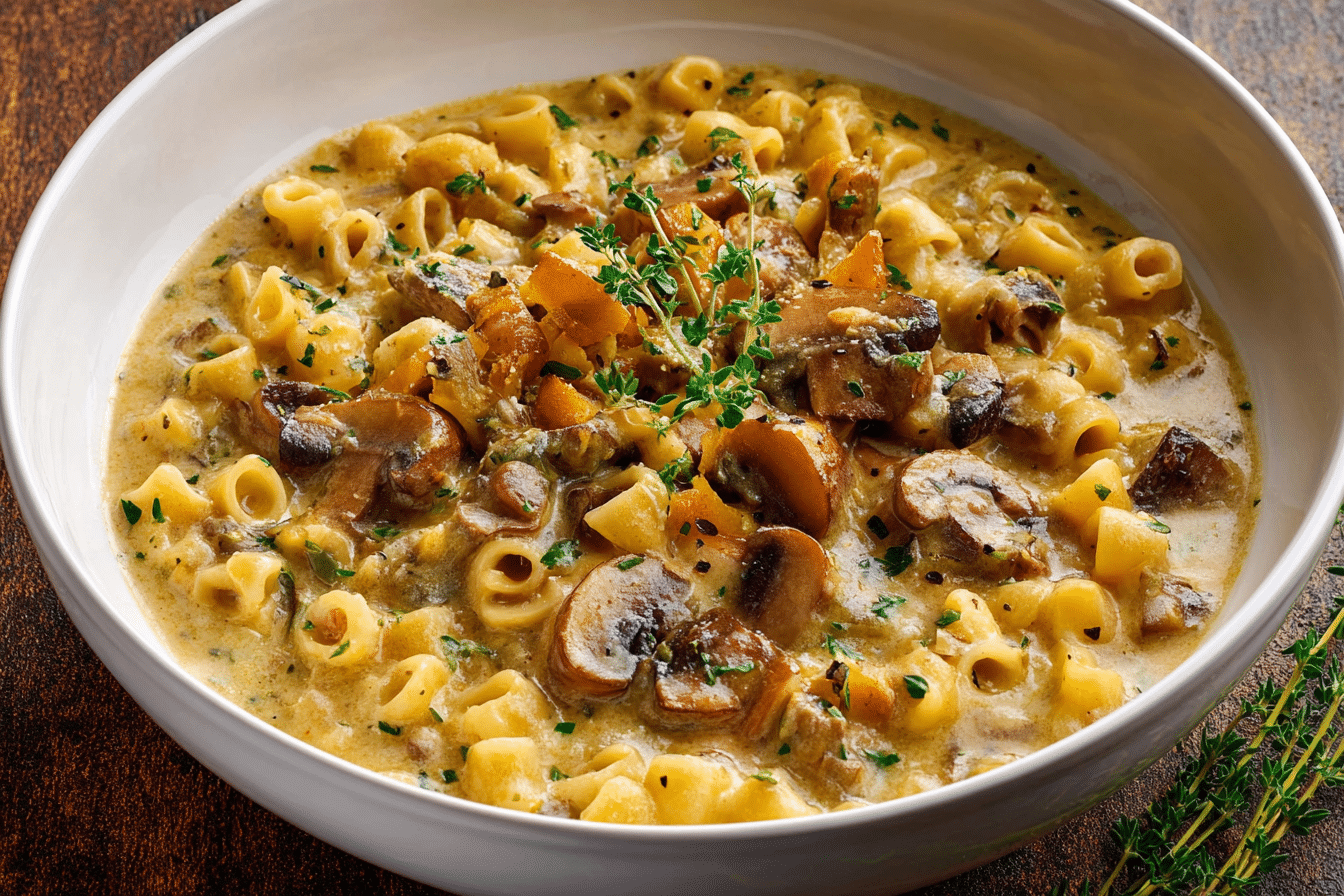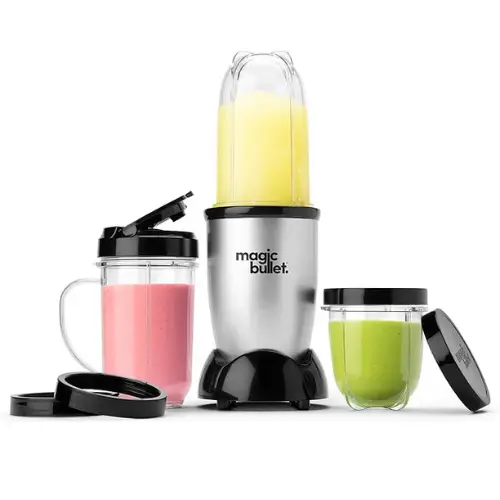Creamy Mushroom Pasta Soup has always been more than just a recipe for us it’s a piece of our kitchen’s history, a dish that shaped the very heart of what we share on our cooking platform. When we first started documenting recipes for our About page, this soup was one of the earliest we ever tested and loved. It wasn’t born from a fancy culinary school technique but from a cozy evening when we wanted something warm, hearty, and nourishing that could feed friends and family without fuss.
Disclosure: This post contains affiliate links.If you click and make a purchase, I may earn a small commission at no extra cost to you.
That evening, our pantry offered mushrooms, pasta, broth, and a small wedge of parmesan. We combined them without overthinking, yet the aroma that filled the room and the creamy, rich texture that followed convinced us we had stumbled upon a forever favorite. This dish became the foundation of many conversations, laughter, and even the start of the journey that eventually led to sharing recipes online.
Over time, we refined the method, learned which mushrooms bring the best flavor depth, and tested variations for everyone—vegetarian, gluten-free, and even vegan versions. Each bowl still reminds us of why we began: to help home cooks create meals that feel like home but taste like they belong in a restaurant.
And now, let’s dig into how you can create the perfect creamy mushroom pasta soup yourself.
Table of Contents
Table of Contents
Why This Creamy Mushroom Pasta Soup Stands Out
What makes this soup different from hundreds of others? It’s not just the creaminess. It’s the layered umami from fresh and dried mushrooms, the balanced seasoning with thyme and dill, and the way pasta cooks right in the broth, releasing starch that naturally thickens the base.
Unlike typical mushroom soups that lean too heavily on dairy, this version keeps the texture light while still rich. The parmesan melts into the broth, not just sitting on top, making every spoonful velvety without feeling heavy.
Print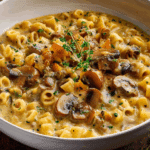
Creamy Mushroom Pasta Soup – 3 Easy Steps to Silky Perfection
- Prep Time: 10 minutes
- Cook Time: 25 minutes
- Total Time: 35 minutes
- Yield: 6 servings 1x
- Category: Soup
- Method: Stovetop
- Cuisine: American-Italian
- Diet: Vegetarian
Description
Creamy Mushroom Pasta Soup is a comforting, hearty dish that blends earthy mushrooms, tender pasta, and a rich, velvety broth. Perfect for cozy dinners, it delivers both the warmth of soup and the heartiness of a pasta meal.
Ingredients
- 2 tbsp olive oil
- 1 tbsp unsalted butter
- 1 medium onion, diced
- 3 cloves garlic, minced
- 12 oz mushrooms, sliced (cremini or button)
- 1 tsp dried thyme
- 1/2 tsp black pepper
- Salt to taste
- 6 cups vegetable or chicken broth
- 1 cup short pasta (ditalini, small shells, or elbow)
- 1 cup heavy cream
- 1/2 cup grated Parmesan cheese
- 2 cups baby spinach (optional)
- Fresh parsley, chopped (for garnish)
Instructions
- Heat olive oil and butter in a large pot over medium heat. Add onions and cook until softened, about 4–5 minutes.
- Stir in garlic and mushrooms; sauté until mushrooms release their moisture and become golden.
- Season with thyme, salt, and black pepper.
- Pour in broth and bring to a boil. Add pasta and cook until al dente, following package instructions.
- Reduce heat to low, stir in heavy cream and Parmesan cheese until the soup becomes creamy.
- Optional: Add spinach and cook until wilted.
- Adjust seasoning, garnish with parsley, and serve hot.
Notes
- For a lighter version, use half-and-half instead of heavy cream.
- Add cooked chicken or turkey for extra protein.
- This soup thickens as it cools; add a splash of broth when reheating.
Nutrition
- Serving Size: 1 bowl
- Calories: 320
- Sugar: 5g
- Sodium: 620mg
- Fat: 18g
- Saturated Fat: 9g
- Unsaturated Fat: 7g
- Trans Fat: 0g
- Carbohydrates: 32g
- Fiber: 3g
- Protein: 10g
- Cholesterol: 45mg
Ingredients for the Perfect Creamy Mushroom Pasta Soup
Crafting an exceptional Creamy Mushroom Pasta Soup begins with selecting the right ingredients. Each component influences the texture, aroma, and final flavor balance, so using quality items is worth the effort.
Mushrooms: The Star Ingredient
Mushrooms drive the earthy depth that makes this soup memorable. A mix of fresh varieties such as cremini, button, or baby bella delivers a robust baseline. Adding a small handful of dried mushrooms—like porcini—intensifies the umami profile. Soaking them beforehand unlocks concentrated mushroom stock, which enriches the broth naturally.
Broths and Flavor Boosters
The liquid you choose sets the entire tone. Beef broth results in a deeper, heartier bowl, while chicken broth creates a lighter, softer background. For a vegetarian version, high-quality vegetable broth works just as well. Optional additions such as soy sauce or Worcestershire sauce provide a subtle savory edge without overpowering the mushrooms.
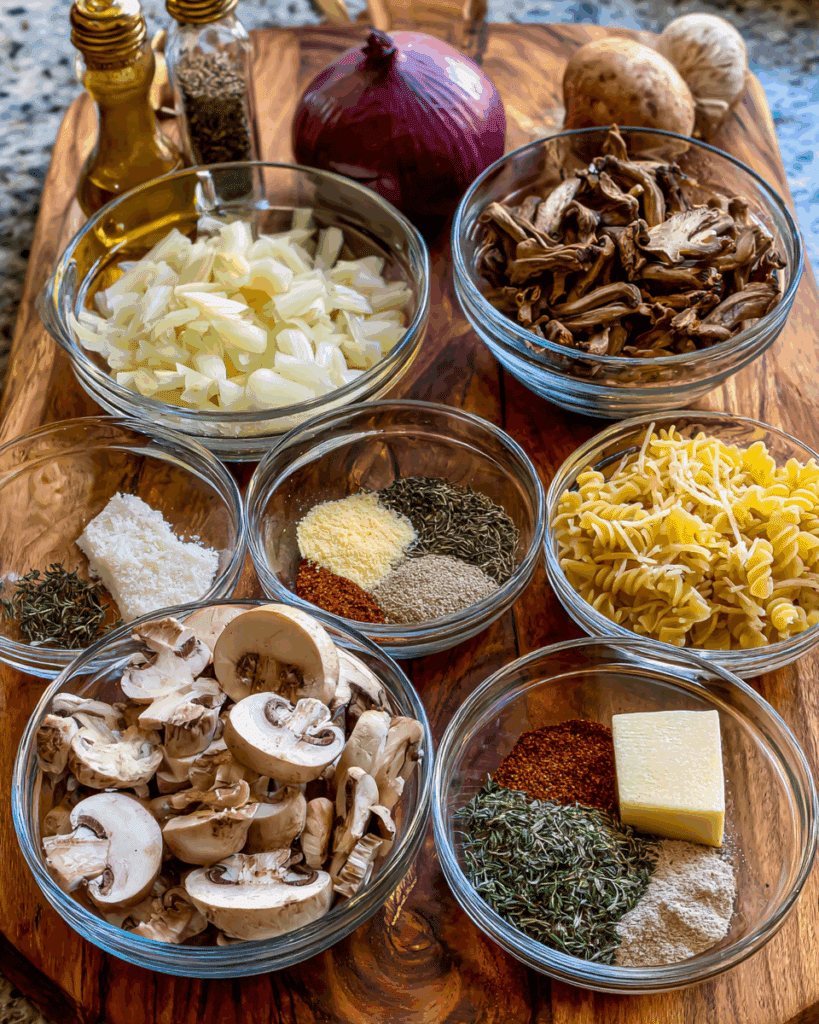
Pasta Selection for the Best Texture
Ditalini pasta is a reliable choice because its small tubular shape holds onto the creamy broth. However, short shapes like elbows or small shells can also work. Avoid long pasta strands—they tend to dominate the bowl instead of complementing the mushrooms.
Aromatics and Herbs
Onion and garlic build the base aroma, while thyme adds a gentle earthiness. Dill, though optional, brightens the profile. Paprika gives an understated smokiness if you prefer a more layered flavor.
Creamy Components
Sour cream is classic for achieving a silky finish, though heavy cream produces a slightly richer texture. Parmesan cheese doesn’t just add saltiness—it melts in and binds everything into a cohesive, velvety soup.
Essential Pantry Staples
Butter (or olive oil) helps with sautéing and adds a subtle richness. Freshly cracked black pepper and a pinch of salt round out the flavors, while the mushroom soaking liquid—never discard it—provides a natural, concentrated stock.
Step-by-Step Cooking Instructions for Creamy Mushroom Pasta Soup
Making Creamy Mushroom Pasta Soup isn’t complicated, but giving each step the attention it deserves ensures a soup that tastes far better than a quick throw-together meal. Here’s how to achieve rich depth, creamy consistency, and perfectly cooked pasta in one pot.
Prepping and Soaking the Mushrooms
Start by addressing the dried mushrooms if you’re using them. Place them in a bowl and pour a cup of just-boiled water over the top. Let them sit for about 10 to 15 minutes, allowing them to soften while releasing an earthy, concentrated broth. Once tender, lift them out, squeeze gently to remove excess liquid, and chop them finely. Don’t discard the soaking water—strain it to remove any grit because it will later enhance the soup’s flavor.
While those are soaking, clean your fresh mushrooms. Instead of rinsing them under running water, which can make them soggy, gently wipe them with a damp paper towel to remove dirt. Then slice or dice them evenly for consistent cooking.
Sautéing for Maximum Flavor
Set a large, heavy-bottomed saucepan over medium heat. Add butter (or olive oil if you prefer a lighter profile) and let it melt until it begins to foam slightly. Toss in the diced onion and stir frequently until it becomes translucent, about five minutes. At this stage, add the chopped soaked mushrooms along with the fresh slices. The goal here is to cook them down slowly, allowing moisture to evaporate and natural sugars to caramelize. This can take around 12–15 minutes but makes a huge difference in building that signature mushroom richness.
Add garlic, thyme, paprika, and dill. Stir continuously for about a minute until their fragrance releases. These aromatics don’t just add taste—they infuse the fat with flavor that will carry throughout the entire soup.
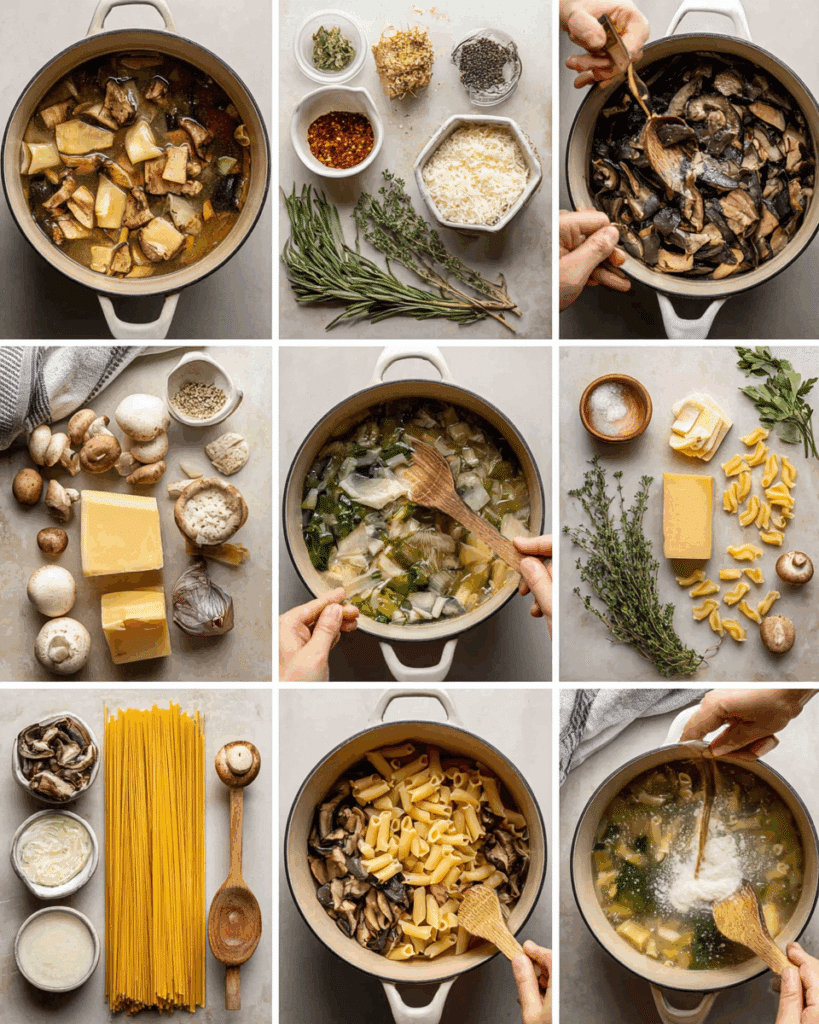
Building the Broth
Now, pour in your chosen broth—beef for a deeper tone, chicken for a milder one, or vegetable if you’re keeping it vegetarian. Stir in the reserved mushroom soaking water to amplify the earthy notes. Optional soy sauce or Worcestershire sauce can be added here to bring subtle complexity. Bring everything to a boil, then reduce the heat to maintain a gentle simmer.
Cooking the Pasta Directly in the Soup
Once the broth is simmering, stir in the pasta. Cooking it directly in the soup saves time, but more importantly, it releases starch into the liquid, giving the base a naturally creamy body before dairy even enters the equation. Keep an eye on the pasta—it should be tender but not mushy, typically taking 8–10 minutes. Stir occasionally to prevent sticking at the bottom of the pot.
Creamy Finish: Dairy and Cheese Choices
Turn off the heat once the pasta reaches perfect doneness. Stir in sour cream (or heavy cream if you want it richer) and grated parmesan. Mix gently until the cheese melts completely and blends into the broth, creating a smooth, velvety consistency. Taste, then season with salt and freshly cracked black pepper to balance all flavors.
Variations of Creamy Mushroom Pasta Soup
A single base recipe for Creamy Mushroom Pasta Soup can lead to several unique versions, each catering to different diets, flavor preferences, or ingredient availability. Experimenting with variations not only keeps your meals exciting but also ensures that everyone at the table can enjoy a bowl tailored to their needs.
Vegan Adaptation
For those avoiding dairy or animal products, swap butter with olive oil or vegan margarine. Replace sour cream with full-fat coconut milk or an unsweetened plant-based yogurt alternative. Parmesan can be substituted with nutritional yeast for a nutty, cheesy flavor without actual cheese. Choose vegetable broth as your liquid base, and you’ll still have a soup that feels indulgent but aligns with vegan choices.
Gluten-Free Version
If gluten sensitivity is a concern, use gluten-free pasta made from rice, corn, or a blend of alternative flours. Check the labels on soy sauce and Worcestershire sauce as well—opt for tamari or a certified gluten-free version. Keep an eye on pasta cooking times, since many gluten-free varieties cook faster and can become overly soft if left unattended.
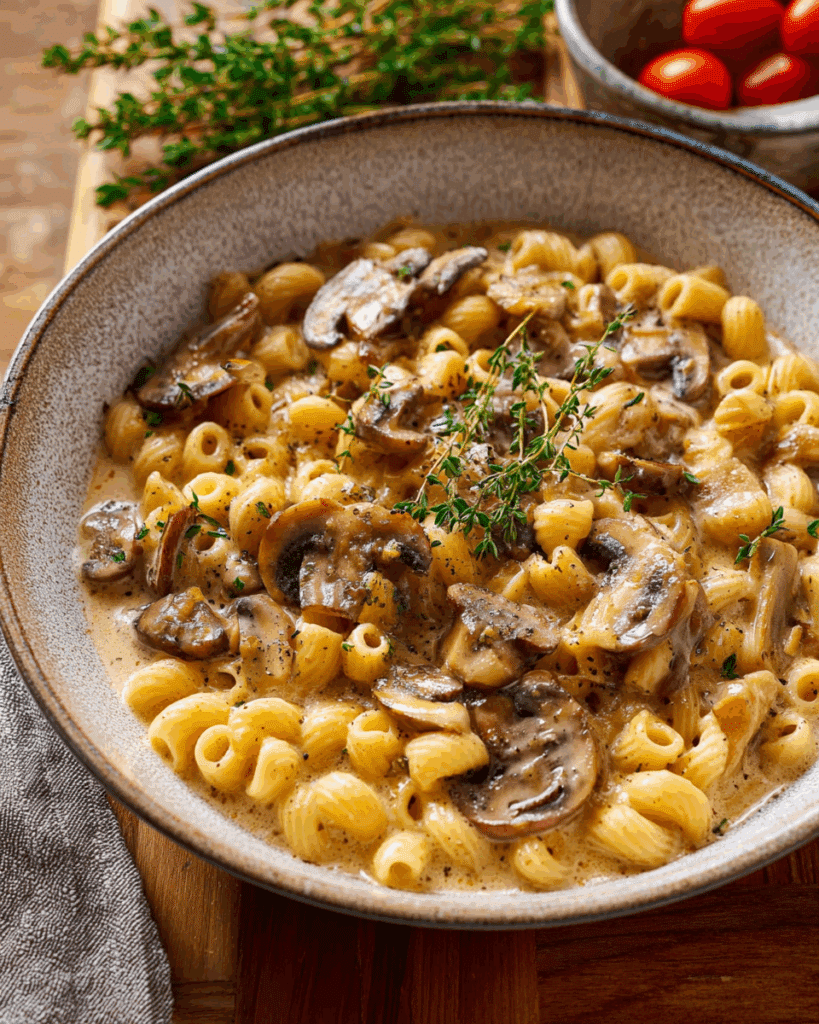
Tips, Tricks, and Chef’s Secrets for the Best Creamy Mushroom Pasta Soup
Perfecting Creamy Mushroom Pasta Soup is less about complicated steps and more about attention to detail. Small adjustments in preparation can transform a decent bowl into one that feels like it came from a professional kitchen. Below is a comprehensive set of tips, drawn from both tested practice and classic cooking wisdom.
1. Focus on Mushroom Treatment
Mushrooms act like sponges, quickly absorbing water. Washing them under running water saturates their texture, which can dilute their flavor when cooked. Instead, use a brush or moist cloth to wash away any debris from each mushroom. Once they hit the pan, give them space. Overcrowding causes steaming rather than browning, which means you miss out on that savory, slightly nutty flavor that comes from caramelization. Use a wide skillet or sauté in batches if necessary.
2. Layer Flavors, Don’t Rush
A soup develops its richness from sequential cooking rather than dumping everything into a pot at once. Start by sweating onions slowly until they’re soft and sweet. Only then add mushrooms, allowing their moisture to evaporate fully before introducing garlic and herbs. This layering builds a depth that a quick sauté simply cannot match.
3. Deglaze for Extra Complexity
After sautéing the vegetables, there’s often a thin layer of browned bits on the bottom of the pan—known as fond. Deglazing with a splash of white wine, broth, or even the reserved mushroom soaking liquid lifts those bits and integrates their concentrated flavor into the soup base. It’s a subtle step that creates a noticeably richer result.
4. Master the Pasta Texture
Cooking pasta directly in the soup has benefits, but it also demands attention. Start checking doneness a minute or two before the package instructions suggest. Remember that pasta continues to soften as the soup rests, so slightly undercooking ensures it doesn’t turn mushy by the time you serve it.
5. Control the Creamy Finish
Add dairy after you’ve removed the soup from direct heat. Sour cream and heavy cream can separate or develop a grainy texture if boiled. Stir them in gently when the liquid is hot but not bubbling, then let the residual heat do the work. Parmesan should also melt slowly; adding it too early can cause clumping.
6. Taste and Adjust Gradually
Mushrooms naturally carry umami, but they can vary in saltiness depending on the broth you use. Season lightly early on and adjust at the end. A pinch of salt can brighten flavors, while a twist of black pepper sharpens the earthy profile. For an extra lift, a small squeeze of lemon juice just before serving balances richness without making the soup tangy.
7. Use the Right Tools
A heavy-bottomed pot distributes heat evenly, preventing hot spots that can scorch dairy or overcook pasta. A wooden spoon helps scrape the bottom gently, keeping all those flavorful bits incorporated into the soup rather than stuck to the pan.
8. Consider Make-Ahead Strategy
If you’re preparing the soup in advance, cook the pasta separately and store it dry. Combine it with the reheated broth just before serving. This prevents the pasta from soaking up too much liquid during storage, ensuring the soup remains creamy rather than overly thick or gluey.
9. Enhance Presentation
A simple garnish can make your Creamy Mushroom Pasta Soup feel restaurant-worthy. Sprinkle extra parmesan, scatter fresh thyme leaves, or drizzle a thin line of good olive oil on top. Even a light crack of black pepper adds visual contrast and an inviting aroma.
Explore savory mushroom‑inspired meals with our Caprese Stuffed Portobello Mushrooms recipe a fresh, cozy vegetarian side that pairs beautifully with creamy soups
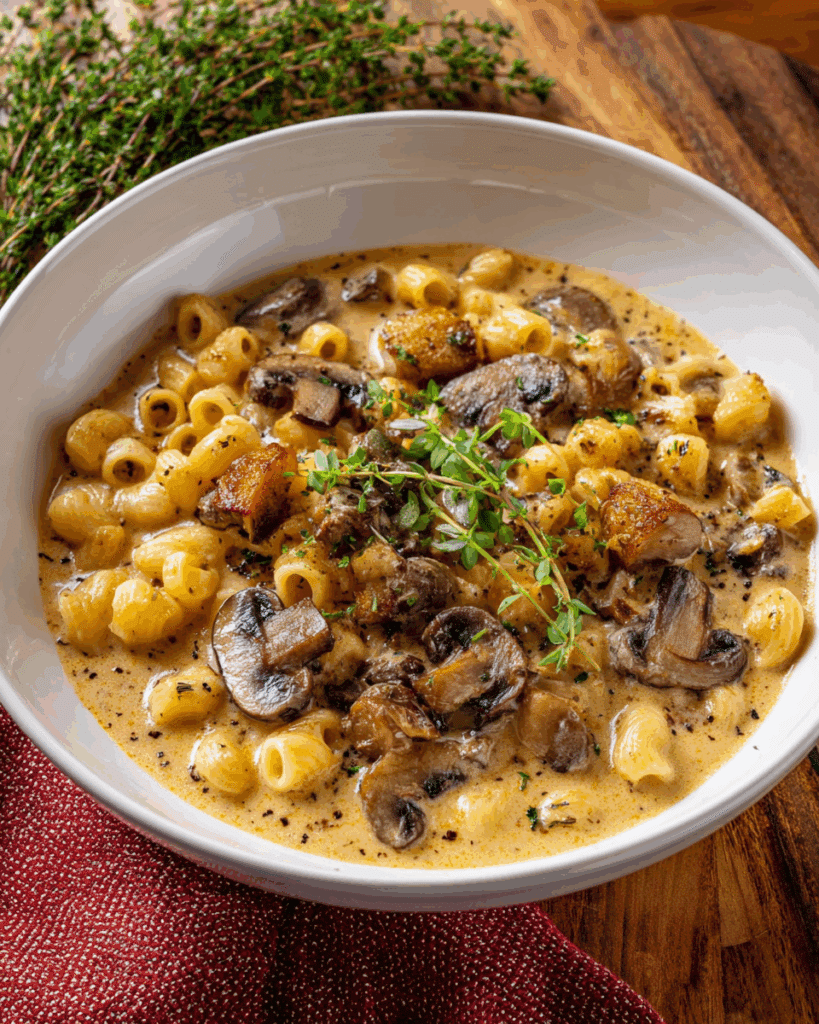
Storage and Reheating Guide
Keeping Creamy Mushroom Pasta Soup at its best beyond the first serving requires careful handling. Because this dish contains dairy, pasta, and delicate mushroom flavors, improper storage or reheating can easily alter its texture and taste. Here’s how to preserve its creamy consistency and rich flavor for later enjoyment.
Cooling Before Storage
Once the soup finishes cooking, allow it to cool slightly before transferring it to containers. Rapidly sealing hot soup can trap steam, leading to excess condensation inside the container. That extra moisture can thin the broth, make the pasta mushy, and even encourage bacterial growth. The safest approach is to leave the pot uncovered for about 20 minutes, stirring occasionally to release heat evenly.
Choosing the Right Containers
Use airtight, shallow containers instead of deep ones. Shallow containers help the soup cool faster, reducing the time it spends in the “danger zone” (between 40°F and 140°F), where bacteria multiply most quickly. Glass containers are preferable to plastic because they don’t absorb odors, they maintain temperature better, and they make reheating easier.
Refrigeration Timeline
Stored properly, Creamy Mushroom Pasta Soup will keep in the refrigerator for about three days. After that, the pasta will likely absorb too much liquid, the mushrooms will soften excessively, and the dairy may begin to separate. If you need to keep it longer, freezing (with modifications) is a better option.
Freezing Strategy
While creamy soups don’t always freeze perfectly, this one can be adapted. For the best results, prepare the base up to the stage before adding sour cream, cheese, and pasta. Freeze that broth-mushroom mixture in a sealed container for up to two months. When ready to serve, thaw it in the refrigerator overnight, heat gently, and then stir in fresh pasta, dairy, and cheese during reheating. This method prevents textural issues that occur when cream and pasta are frozen.
Reheating for Best Quality
When reheating refrigerated soup, avoid rushing the process. High heat can cause dairy to curdle and pasta to break down. Instead:
- Stovetop Method (Preferred): Pour the soup into a pot and warm it over low to medium heat. Stir continuously to prevent sticking, and if the soup has thickened, add a splash of broth or milk until it reaches the desired consistency.
- Microwave Method (Quicker): Place the soup in a microwave-safe bowl, cover loosely, and heat in 30-second intervals, stirring between each to keep it smooth. Use medium power rather than high.
Avoiding Separation
If you notice slight separation—tiny beads of fat or a grainy texture—whisk the soup gently while it’s warming. Often, this brings the creaminess back together. Adding a teaspoon of cream or milk can also help restore its smooth texture.
Serving Leftovers Creatively
If you have leftover soup but not enough for a full meal, consider repurposing it. Use it as a sauce for baked chicken, stir it into cooked rice for a quick risotto-style dish, or blend it for a thicker mushroom sauce to pour over roasted vegetables. This prevents waste while keeping your meals interesting.
Try our Creamy Mushroom and Asparagus Chicken Penne for another luscious mushroom‑based pasta dish with cream and parmesan
Serving Suggestions and Pairings
A bowl of Creamy Mushroom Pasta Soup is satisfying on its own, yet thoughtful pairings can transform it from a simple meal into a more complete dining experience. The key is to complement its rich, earthy profile with sides and beverages that either balance or enhance its flavors.
Bread Pairings
Freshly baked bread remains a classic companion. A crusty baguette or sourdough loaf is ideal because its firm exterior and airy interior soak up the creamy broth without becoming overly soggy. Garlic bread offers a more indulgent option, infusing additional aroma while adding a crunchy texture contrast. For lighter alternatives, consider whole-grain rolls—they introduce a nutty note that mirrors the earthy mushrooms.
Salad Companions
Since the soup leans toward richness, pairing it with a crisp salad keeps the meal from feeling too heavy. A simple mixed greens salad dressed with a tangy vinaigrette cuts through the creaminess. Alternatively, a spinach and apple salad with walnuts provides a sweet, crunchy counterpoint that refreshes the palate between spoonfuls.
Vegetable Sides
Roasted vegetables—especially carrots, Brussels sprouts, or asparagus—complement the umami tones while adding variety to the plate. The caramelized edges of roasted vegetables echo the browned mushrooms in the soup, creating a cohesive flavor theme without feeling repetitive.
Protein Additions
For those who want extra protein, serve the soup alongside grilled chicken breast, roasted turkey slices, or even seared tofu for a vegetarian-friendly option. These proteins don’t overpower the dish but make it more filling for larger appetites.
Wine and Beverage Choices
If you’re pairing wine, opt for something that complements the soup’s earthy, creamy character. A light Pinot Noir or an oaked Chardonnay works particularly well. For non-alcoholic choices, sparkling water with a squeeze of lemon offers a refreshing counterbalance, while a mild iced tea keeps the meal light and easy.
Garnishes and Finishing Touches
Don’t underestimate the power of garnishing. A sprinkle of freshly grated parmesan, a dusting of black pepper, or a few thyme leaves on top makes each bowl look and taste more refined. A drizzle of quality olive oil or even truffle oil can elevate the dish into something that feels restaurant-quality without extra effort.
Conclusion: Why Creamy Mushroom Pasta Soup Belongs on Your Table
Creamy Mushroom Pasta Soup is more than just a meal—it’s comfort, warmth, and depth in one bowl. Its earthy mushrooms, tender pasta, and velvety broth create a dish that feels indulgent yet approachable, perfect for family dinners or casual gatherings. With endless variations, simple preparation, and flavors that improve with time, it’s a recipe worth mastering and repeating. Every spoonful reminds you that homemade food can be both satisfying and remarkably easy to elevate.
Creamy Mushroom Pasta Soup is just the beginning when it comes to cozy, comforting dishes. If you enjoyed this recipe, you might also love Creamy Parmesan Italian Sausage Soup
Frequently Asked Questions (FAQs) About Creamy Mushroom Pasta Soup
Can I freeze Creamy Mushroom Pasta Soup?
Freezing Creamy Mushroom Pasta Soup works if you adjust the preparation. Make the base without adding cream, cheese, or pasta, then freeze it. When you’re ready to serve, thaw it overnight, reheat slowly, and stir in the dairy and pasta fresh. This prevents texture changes that can occur when creamy soups are frozen.
How do I keep Creamy Mushroom Pasta Soup from curdling?
To keep Creamy Mushroom Pasta Soup silky, add sour cream or heavy cream only after removing the pot from direct heat. Boiling dairy can cause separation. Stir gently and let the residual heat integrate the cream smoothly into the soup.
Can I make Creamy Mushroom Pasta Soup ahead for a party?
Yes, but for the best texture, prepare the soup without pasta. Store the base in the refrigerator for up to two days, then cook the pasta separately just before serving. Combine them right before mealtime so the pasta doesn’t absorb too much liquid and the Creamy Mushroom Pasta Soup remains perfectly balanced.
What mushrooms are best for Creamy Mushroom Pasta Soup?
Cremini, baby bella, or a blend that includes porcini provide deep umami flavor. Dried mushrooms add even more complexity to Creamy Mushroom Pasta Soup, so using both fresh and dried varieties delivers the richest result.
Is there a way to make Creamy Mushroom Pasta Soup low-fat?
Yes. Swap sour cream for Greek yogurt, use less parmesan, and choose olive oil instead of butter. The soup will still taste creamy but with reduced fat content while maintaining the classic essence of Creamy Mushroom Pasta Soup.
What’s the best pasta shape to use in Creamy Mushroom Pasta Soup?
Small shapes like ditalini, elbows, or mini shells work best. They cook evenly, hold onto the creamy broth, and don’t overpower the mushrooms. Long pasta strands aren’t ideal for Creamy Mushroom Pasta Soup because they make the soup harder to eat and alter the texture balance.

